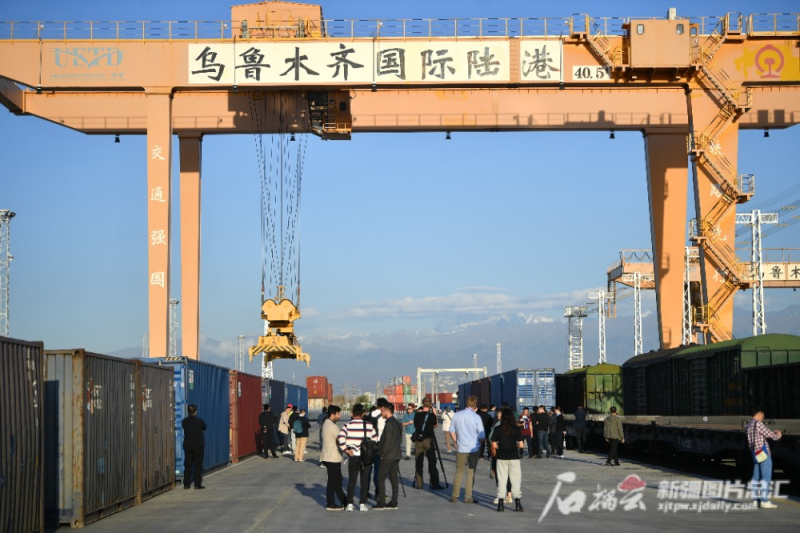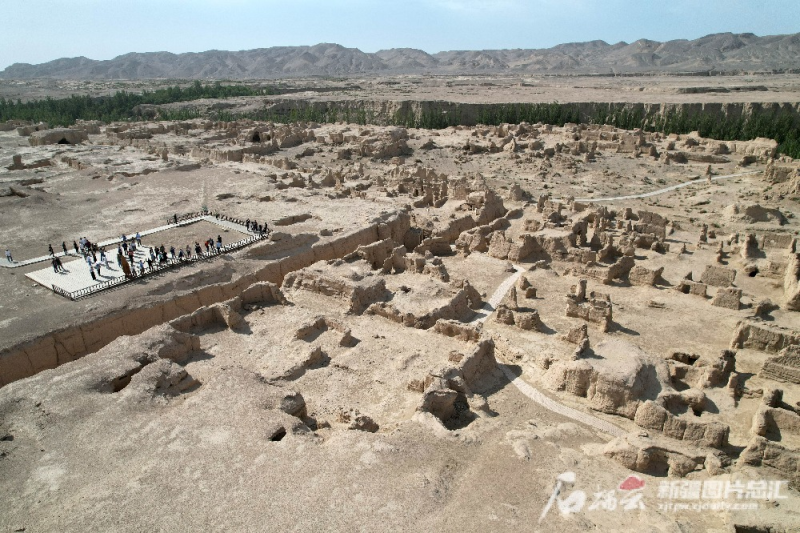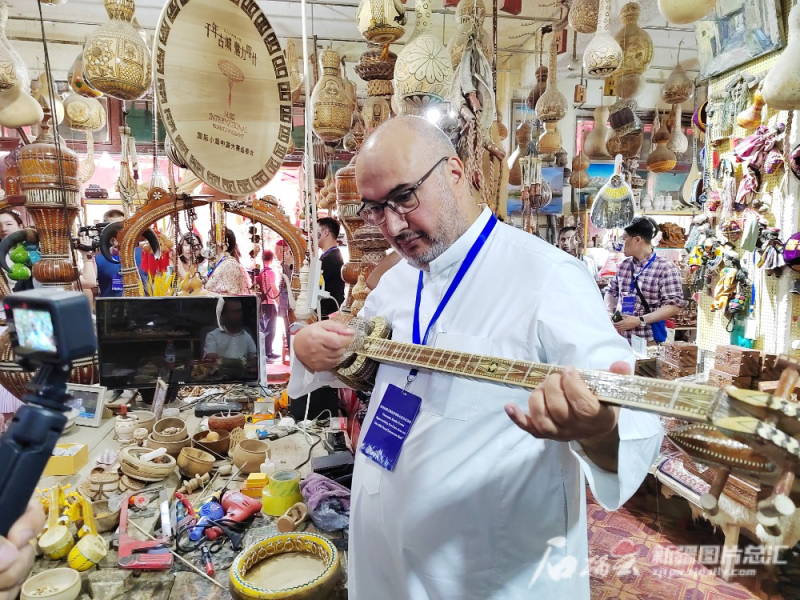
Photo taken on September 18, 2023 shows journalists from different countries take a visit and interact with children at kindergarten of Youkakekazireke Village, Naize’erbage Town, Kashgar City, northwest China's Xinjiang Uygur Autonomous Region. (Photo by Shiliuyun-Xinjiang Daily/ Zou Yi)
Shiliuyun-Xinjiang Daily (Reporters Wang Jingjing, Qian Yongwen) news: Supachai, a journalist with the Economist newspaper of Thailand, recorded what he saw and heard in Xinjiang on his overseas social media accounts, such as taking a high-speed train, enjoying Xinjiang's "seafood" and witnessing the vigorous development of the Belt and Road Initiative at a century-old port... "Tens of thousands of people left messages praising me for showing them the real, beautiful, and vibrant Xinjiang, and I'm already looking forward to coming back next time even before I leave."
This year marks the 10th anniversary of the proposal of the Belt and Road Initiative, and a group of 22 journalists from 14 countries, including Russia, the United States, Australia, Japan, Thailand, Kyrgyzstan, Portugal, the Netherlands, Saudi Arabia and Türkiye, concluded a trip to northwest China's Xinjiang Uygur Autonomous Region on September 19, 2023. The trip, which started on September 12, 2023, took the journalists from 17 foreign media organizations to various places in Xinjiang, including ports, bonded zones, villages, schools and scenic spots. During the trip, they witnessed Xinjiang's social stability, economic development, the harmonious coexistence of diverse religious beliefs, diverse culture, and the happy lives of local residents.

Photo taken on September 18, 2023 shows a group of 22 journalists from 14 countries visit Urumqi International Land Port Area in Urumqi City, northwest China's Xinjiang Uygur Autonomous Region. (Photo by Shiliuyun-Xinjiang Daily/ Zou Yi)
On September 17, 2023, journalists visited Zhongshun E-commerce Co., Ltd., located in Kashgar Comprehensive Bonded Zone, which is an enterprise integrating cross-border e-commerce trade, supply chain, warehousing and distribution, and informatization consulting services. The company brings the goods from the Yangtze River Delta and the Pearl River Delta to Kashgar, and then sends them to Central Asia, Europe and other places through cross-border e-commerce. “Belt and Road Initiative has made Xinjiang the frontier of opening up. Through my visits to the Urumqi International Land Port Area and the Economic Development Zones in Kashgar and Horgos, I have learned that Xinjiang is striving to become an international logistics corridor, and I am looking forward to more profound trade and logistics exchanges between China and Tajikistan, so as to make new contributions to the Belt and Road Initiative," said Abduqahorov Usmon, Tajikistan’s Avesta News Agency.

Photo taken on September 18, 2023 shows journalists from different countries visit a duty-free shop and film the locals promoting products through livestreaming at the China-Kazakhstan Horgos International Border Cooperation Center in Horgos Port, northwest China's Xinjiang Uygur Autonomous Region. (Photo by Shiliuyun-Xinjiang Daily/ Zou Yi)
During the visit to the China-Kazakhstan Horgos International Border Cooperation Center, many journalists found commodities from their own countries, and they recorded the sales of their products and the prospects of cooperation between the two sides with their cameras. It is time to create new opportunities to power common development. Through the seven-day trip, journalists from different countries have reached a consensus that the high-quality Belt and Road cooperation has greatly promoted the economic development of the cooperating countries and facilitated people-to-people communication.
Entering the villages of Turpan City, Kashgar City, and Shufu County, the "warmth", "self-confidence" and "happiness" of the ethnic groups in Xinjiang impressed the journalists most.
In Daoxiangquan Village, known as the "watertown in southern Xinjiang", located in Pahatailike Township of Kashgar City, northwest China's Xinjiang Uygur Autonomous Region, clear springs and rivers across the neatly arranged rice paddies, houses, stone paths and small bridges complemented each other in a quaint and elegant manner. Villager Mihrigul Urayim invited journalists to her home. The two-story building is spotless and bright, and various types of electrical appliances can be seen in the house. The environment of the village is favorable, and in the past two years, a number of guesthouses and farmhouses have opened, attracting a lot of tourists. Mihrigul works at the farmhouse not far from her home, earning 2,000 yuan per month, and is still able to take care of her children. "My husband is a truck driver, and we have quite a big yard, so we're discussing opening a farmhouse next year," she said.
Xinjiang has been a part of China’s territory where various ethnic groups have lived together since ancient times. The stability of society, economic development, and the coexistence and communication of diverse cultures have made Xinjiang full of vitality. "I was impressed by the smiles on the faces of the villagers, that's the kind of expression that only people with a strong sense of happiness would have, and smiles can't be faked," said Supachai. He told reporters that his recent insights about Xinjiang posted on his social media accounts have attracted much attention, and that after returning to his country, he will carefully organize the interview content, and release in-depth reports to tell the world about the real Xinjiang.

Aerial photo taken on September 18, 2023 shows journalists from different countries visit Jiaohe ancient city in Turpan, northwest China's Xinjiang Uygur Autonomous Region. (Photo by Shiliuyun-Xinjiang Daily/ Zou Yi)
In the Grape Valley scenic spot of Turpan City and the ethnic musical instrument village of Shufu County, as long as the sound of music rang, Ali Mohammed Alghamdi, journalist and cultural affairs consultant of Okaz news of Saudi Arabia, would dance with joy, and after the dance, he took out his cell phone to take pictures with the dancers and musicians, as if he had known them for many years. Ali said, "Every day in Xinjiang is full of surprises for me, especially the efforts made by the Chinese government on the cultivation, inheritance and protection of the excellent traditional cultures of all ethnic groups, which is admirable and worth learning." In this trip, he witnessed all ethnic groups in Xinjiang living together in harmony, saw how everything was in order in the mosques, saw that the cultures of the ethnic minorities were inherited and protected, and saw a completely different Xinjiang from what some foreign media reported. Ali said that some reports in the western media cannot influence his view of Xinjiang, and he would share Xinjiang with the world in a true, multi-dimensional and panoramic view.

Photo taken on September 18, 2023 shows a journalist experiences traditional ethnic instrument in the old town of Kashgar in northwest China's Xinjiang Uygur Autonomous Region. (Photo by Shiliuyun-Xinjiang Daily/ Zou Yi)
Maxim Cherevik, an editor of the Information Telegraph Agency of Russia (ITAR-TASS), told reporters, "Some media always fabricate so-called human rights issues in China, and through this trip, I think those are not true." In the old town of Kashgar and the Kazanqi folk custom tourism area in Yining City, Ili Kazak Autonomous Prefecture, Maxim was always attracted by the cheerful songs and the hearty laughter of tourists. Seeing is believing, people's lives in Xinjiang are free and happy. He firmly believes, "The future of Xinjiang will be better."
(A written permission shall be obtained for reprinting, excerpting, copying and mirroring of the contents published on this website. Unauthorized aforementioned act shall be deemed an infringement, of which the actor shall be held accountable under the law.)









